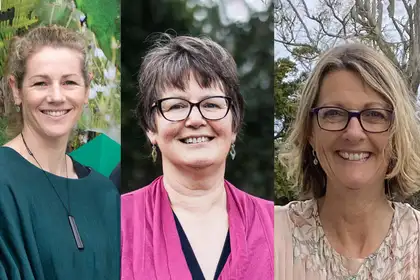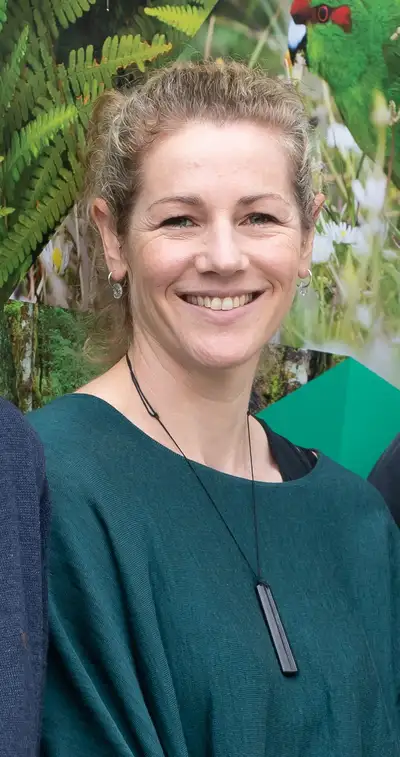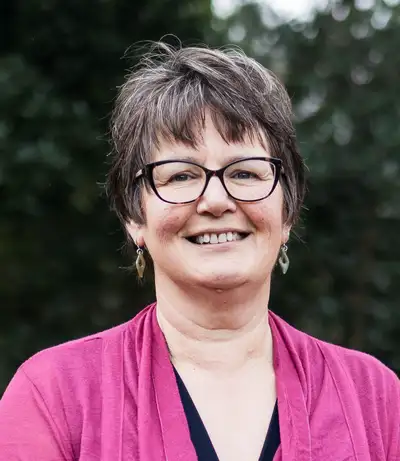
Professor Ngaio Beausoleil, Professor Jackie Benschop and Professor Wendi Roe.
Professor Ngaio Beausoleil – Co-Director of the Animal Welfare Science and Bioethics Centre, Professor of Animal Welfare Science
Professor Ngaio Beausoleil‚Äôs passion for animal welfare has long been recognised ‚Äì in high school she was voted ‚ÄòMost likely to run over a child to avoid running over a kitten‚Äô. Alongside her interests in science and biology, she originally planned to join the vet programme at Te Kunenga ki P≈´rehuroa √€∂π ”∆µ, only for her career direction to change after meeting Professor Emeritus David Mellor.
“He showed us how science could be used to credibly understand animal welfare and I decided to take up a PhD scholarship to pursue animal welfare science research instead. This field is conceptually challenging but foundational to the veterinary profession and there is no risk of getting bored!”
Professor Beausoleil’s research focuses on improving animal welfare through scientific methods, addressing everything from pest control and wildlife conservation to pain relief for farmed animals. She is particularly interested in understanding how experiences such as pain, breathlessness and nausea affect animal welfare. Since many indicators of these experiences are behavioural, she emphasises the importance of designing experimental paradigms that allow animals to show what they’re experiencing through their behaviour.
“I’m awed by some of the sophisticated methods animal welfare scientists design to explore animal experiences, even in animals like hermit crabs! I’m also interested in applying animal welfare science principles and methods in new contexts and have been working more at the interface of conservation and welfare, including to improve the humaneness of methods used to control introduced species.”
In addition to her research, Professor Beausoleil has provided policy advice to governments, animal industries and veterinary professional bodies worldwide. She balances this with her role as an educator, finding ways to connect her research with what she teaches her students, alongside lots of coffee!
“I love it when my research and teaching align, as it makes both more exciting and relevant. I want my students to go away with an understanding that we can apply rigorous scientific methods to build robust evidence supporting animals’ mental experiences and welfare states. I also hope they leave a little dissatisfied with the way humans continue to ignore the welfare problems that are staring us in the face.”
A major highlight in Professor Beausoleil’s career came recently when she was awarded the 2025 Universities Federation for Animal Welfare Medal for Outstanding Contributions to Animal Welfare. She was recognised for her dedication and evidence-based approach, which has helped shape modern animal welfare. She now joins an elite group of global scientists recognised for their world-leading contributions to animal welfare science, including Professor Marian Stamp Dawkins, Professor John Webster and Professor Donald Broom.
One of her favourite aspects of the job is working with postgraduate researchers, especially PhD students.
“I love seeing the development of my future colleagues, some of whom are much cleverer than me! It’s also incredibly rewarding to see how my research has contributed to improving the welfare of animals in various ways, particularly for the kinds of animals that aren’t loved or valued in the traditional sense.”

Professor Ngaio Beausoleil.
Professor Jackie Benschop – Professor of Veterinary Public Health
Growing up in Christchurch, Professor Jackie Benschop always dreamed of being a vet. She considers herself fortunate to have had the opportunity to attend vet school, as in 1982, selection was based solely on academic performance.
It wasn’t until 2003, after deciding to study further, that Professor Benschop’s interest in epidemiology began. She was connected with Massey’s EpiCentre, the largest veterinary epidemiology training and research centre in Australasia, and became immersed in the study of disease patterns and prevention. Looking back, she says it was the right place at the right time, with a bit of luck involved.
“I had been in clinical practice for many years and was seeking a change. The idea of attempting to quantify and model risks and diseases was very interesting to me.”
Professor Benschop was offered a PhD programme in epidemiology and moved her whānau from Whangārei to Palmerston North to pursue it. During her studies, her interest in infectious diseases at the human-animal-environment interface grew steadily.
“It was my favourite subject at vet school, especially learning about the life cycles of parasites. While working as a veterinarian, I became more interested in zoonoses, diseases transmitted from animals to humans, and the powerful human-animal bond, particularly with companion animals and farm stock. I also began to understand the environment’s role in disease transmission. My time working in export meat plants in the late 1990s opened my eyes to the challenges faced by those in farming and food production.”
Over the past 15 years, Professor Benschop has deepened her understanding of One Health, the concept that human, animal and environmental health are interconnected and that the wellbeing of each is closely linked to the others. Through her work and personal experiences, she says she’s come to appreciate the importance of healthy ecosystems and the effects of environmental degradation and climate change.
Professor Benschop says it’s important to understand how veterinary professionals play a vital role in not only safeguarding animal health but also in protecting human health.
“While veterinarians in Aotearoa are most often recognised for their clinical work, their contributions to human and animal health extend far beyond the clinic. From advising on zoonoses such as ringworm and salmonella, antimicrobial stewardship and post-disaster consultations, to working with government, industry bodies, academia and research, their roles are much boarder. Their behind-the-scenes work on zoonotic diseases, meat hygiene and infectious disease modelling also shape important decisions in human health.”
For Professor Benschop, the most rewarding part of her role is contributing to people’s happiness and wellbeing.
“I’m committed to being the best I can be at group co-leading, mentoring, supervising and teaching, while also creating and sharing knowledge about how to stay safe regarding infectious diseases. My work also extends to community engagement and addressing social justice issues.”
For those aspiring to follow a similar path, Professor Benschop advises a holistic approach to both technical and personal development.
“In epidemiology and infectious disease research, technical competence is essential and can be learned. But what’s equally important is the ability to understand that your way is not the only way. Be open and curious about others’ expertise and perspectives. Strive to be the best version of yourself, recognise the assumptions behind your work and continually develop your communication skills.”

Professor Jackie Benschop.
Professor Wendi Roe – Deputy Head of School, Professor of Veterinary and Marine Mammal Pathology
During her undergraduate studies, Professor Wendi Roe found she was drawn to veterinary pathology – the study of disease in animals and its effects on their bodies - but didn’t consider it as a career option until she’d been in practice for 10 years. The impetus for change came with the arrival of her first baby, which led to a challenging 12-month period where she and her husband, also a veterinarian, had to balance their careers with family life, with one of them always on call. Seeking change, Professor Roe and her family relocated to Palmerston North so she could pursue a pathology residency at the vet school.
She says her original plan was to complete the residency and then secure a nine-to-five job in a veterinary diagnostic laboratory.
“I soon realised that I really loved teaching, so I stayed on. And as it turns out, diagnostic lab jobs aren’t exactly nine-to-five, so keep that in mind if you’re considering a similar path!”
Professor Roe describes her move into marine mammal pathology as a fortunate accident.